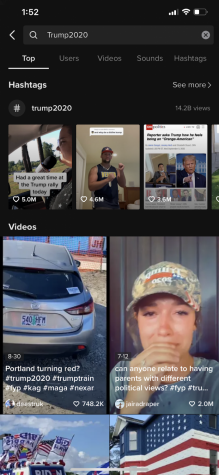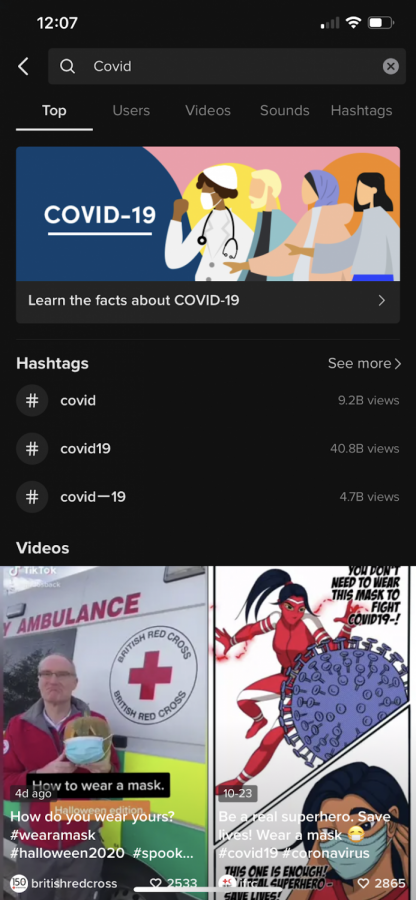Detective TikTok and Trump’s COVID-19 Case
The lack of information about President Trump’s COVID-19 diagnosis resulted in amateur sleuths on TikTok trying to fill in the gaps.
Although posts tagged “#covid” receive a notification about fact checking, in reality, the app’s limited fact checking capability has led to the spread of false information.
TikTok plays a role in providing information, especially to younger people, about COVID-19, politics, and current events, but it is also a source of rumors and misinformation during times of uncertainty. The circumstances surrounding President Trump’s recent COVID-19 diagnosis led to a proliferation of rumors and speculations.
On October 2, 2020, three days after mocking Joe Biden for wearing a mask, President Trump announced via Twitter that he and his wife, Melania had tested positive for COVID-19. Initial reports from the White House stated that Trump had a low grade fever, but with no serious symptoms. A few hours later, he was photographed being moved to Walter Reed Hospital via helicopter.
The White House Press Secretary, Kayleigh McEnany, divulged very little information as to when and where Trump was exposed to the virus, and little was known about his condition. Information was leaked that Trump’s oxygen levels dropped substantially, sparking rumors on TikTok that he was in critical condition.
The next day, Trump’s doctors held a press briefing where they stated the President was in good condition and recovering after receiving an experimental cocktail of antibiotics and steroids. That same day, Kellyanne Conway announced her positive COVID-19 diagnosis on Twitter after her daughter, Claudia Conway, revealed the positive test on her TikTok account.
TikTok became a huge source of information about COVID-19 in the White House after Claudia Conway broke the news of her mother’s condition. Users watched videos explaining the circumstances and events of Trump’s case in the short and simple format of TikTok videos. “There was a lot of information on TikTok, and the people [who posted the videos] made the timeline very clear, which was helpful,” said Jennifer Lee ’22.
Mainstream media’s conflicting information and reporting of conflicting timelines has led to much confusion, enforcing TikTok’s prominent role in informing users of Trump’s condition. TikTok had already played a large role in the spread of political news, but Claudia Conway’s bombshell video led to a higher focus from traditional forms of media on the platform.
Tiktok also experienced a surge in videos speculating about Trump’s diagnosis as more information was revealed. The timeline between Trump’s diagnosis and hospitalization led many users to point out inconsistencies between the Press Secretary’s statements and the usual progression of the Coronavirus.
Users noted the incubation stage for COVID-19 is two to fourteen days, but Trump participated in the first presidential debate with former Vice President Joe Biden only three days before testing positive, meaning he likely had COVID-19 during the debate. According to the guidelines set for the debates, both parties were to be tested for COVID-19 before the event, adding to the growing confusion as to why Trump was not forbidden from participating. However, a few days later, the moderator, Chris Wallace, announced on Fox News that Trump arrived late to the debate and was not tested for COVID-19.
Users seized upon this revelation and went on to post TikTok videos stating that Trump purposely missed the testing window for the debate because he knew that he had COVID-19. They pointed out the only instances where COVID-19 symptoms appear two days after contracting the virus are in the most severe cases, meaning Trump’s mild infection was not recent. The positive diagnosis of Hope Hicks and Kellyanne Conway also led users to observe that the celebration for Amy Coney Barrett’s Supreme Court nomination on September 26th, 2020 could have been a super-spreader event. This belief was further enforced by the increasing number of Republicans and Cabinet members testing positive.
“I first learned about the super spreader event from TikTok. There were so many videos on that because all these Republicans got [COVID-19],” said Bryce Zampty-Hicks ’22. Reports soon came out that the event disregarded social distancing guidelines, including an indoor segment which contributed to the rapid spread of COVID-19. Many photos circulated online of attendees not wearing masks while being in close proximity to each other, which furthered the credibility of the users claims.
Tiktok users were split over Trump’s condition, with some speculating that he was in a critical condition after viewing a poorly edited video of President Trump at Walter Reed seemingly having difficulty breathing and suppressing coughs during his address to the American public. Claudia Conway commented that Trump was in a poor condition and was struggling to breathe which furthered rumors; however, she later retracted her statements.
Moreover, President Trump’s speedy recovery sparked rumors that he faked his diagnosis in order to gain sympathy from American voters. One TikTok user pointed out that Boris Johnson’s popularity levels rose after contracting and surviving COVID-19 in April 2020 and that Trump could be using a COVID-19 diagnosis as a last ditch attempt to win over voters. “I don’t know if he faked it or not. There was so much information and there were so many different rumors on TikTok. I don’t what to believe anymore,” said Lee ’22.

These TikTok videos received hundreds of thousands of views, with some commenters in agreement with the claim. “I don’t trust Trump. He has a history of lying, and the circumstances surrounding the events are too suspicious. [Conway’s videos] were convincing. She has insider information because she’s Kellyane’s daughter,” said Zampty-Hicks ’22. Users also noted it was highly unlikely that Trump would recover in three days because he had depleted oxygen levels, required an oxygen tank, and was treated with experimental drugs. These are all signs of a dangerous infection. They also pointed out that Trump’s health and age makes the situation unbelievable; Trump is clinically obese and 74 years old, putting him in the at-risk category for serious complications from contracting COVID-19.
TikTok’s role as a news source has been steadily increasing regardless of its capability to fact-check, and the rumors show its influence is apparent.
“I don’t know if he faked it or not. There was so much information. and there were so many different rumors on TikTok. I don’t what to believe anymore,” said Jennifer Lee ’22.
Carolyn Chui is an Editor-in-Chief for ‘The Science Survey.’ She enjoys writing articles on politics, business, and international relations. Carolyn...

